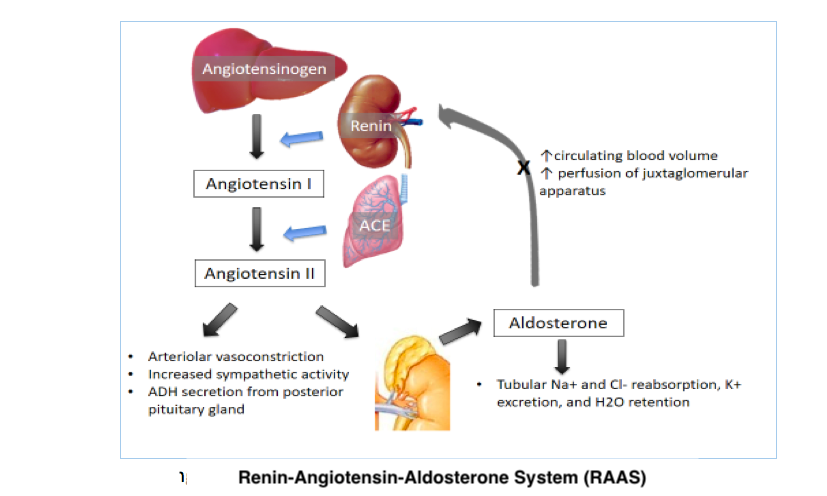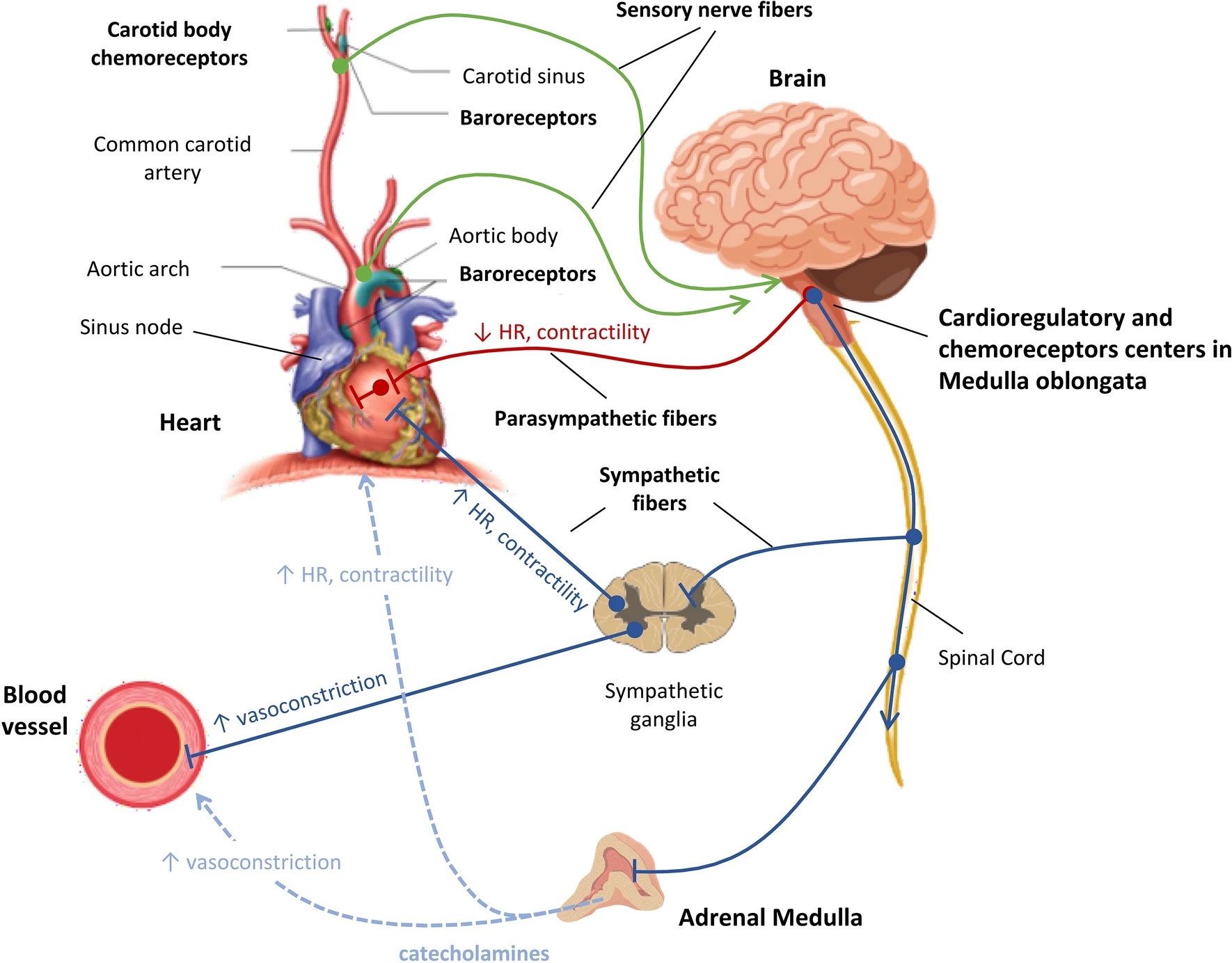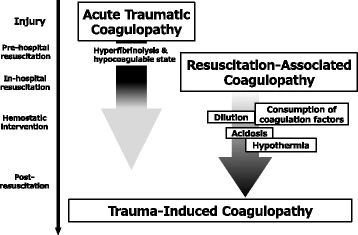[1]
Bickell WH, Wall MJ Jr, Pepe PE, Martin RR, Ginger VF, Allen MK, Mattox KL. Immediate versus delayed fluid resuscitation for hypotensive patients with penetrating torso injuries. The New England journal of medicine. 1994 Oct 27:331(17):1105-9
[PubMed PMID: 7935634]
[2]
Morrison CA, Carrick MM, Norman MA, Scott BG, Welsh FJ, Tsai P, Liscum KR, Wall MJ Jr, Mattox KL. Hypotensive resuscitation strategy reduces transfusion requirements and severe postoperative coagulopathy in trauma patients with hemorrhagic shock: preliminary results of a randomized controlled trial. The Journal of trauma. 2011 Mar:70(3):652-63. doi: 10.1097/TA.0b013e31820e77ea. Epub
[PubMed PMID: 21610356]
Level 1 (high-level) evidence
[3]
Smith JB, Pittet JF, Pierce A. Hypotensive Resuscitation. Current anesthesiology reports. 2014 Sep 1:4(3):209-215
[PubMed PMID: 25294973]
[4]
Barak M, Rudin M, Vofsi O, Droyan A, Katz Y. Fluid administration during abdominal surgery influences on coagulation in the postoperative period. Current surgery. 2004 Sep-Oct:61(5):459-62
[PubMed PMID: 15475095]
[5]
Torres LN, Sondeen JL, Ji L, Dubick MA, Torres Filho I. Evaluation of resuscitation fluids on endothelial glycocalyx, venular blood flow, and coagulation function after hemorrhagic shock in rats. The journal of trauma and acute care surgery. 2013 Nov:75(5):759-66. doi: 10.1097/TA.0b013e3182a92514. Epub
[PubMed PMID: 24158192]
[6]
Geeraedts LM Jr, Kaasjager HA, van Vugt AB, Frölke JP. Exsanguination in trauma: A review of diagnostics and treatment options. Injury. 2009 Jan:40(1):11-20. doi: 10.1016/j.injury.2008.10.007. Epub 2009 Jan 8
[PubMed PMID: 19135193]
[7]
Brenner M, Stein DM, Hu PF, Aarabi B, Sheth K, Scalea TM. Traditional systolic blood pressure targets underestimate hypotension-induced secondary brain injury. The journal of trauma and acute care surgery. 2012 May:72(5):1135-9. doi: 10.1097/TA.0b013e31824af90b. Epub
[PubMed PMID: 22673237]
[8]
. The Brain Trauma Foundation. The American Association of Neurological Surgeons. The Joint Section on Neurotrauma and Critical Care. Hypotension. Journal of neurotrauma. 2000 Jun-Jul:17(6-7):591-5
[PubMed PMID: 10937905]
[9]
Tremblay LN, Rizoli SB, Brenneman FD. Advances in fluid resuscitation of hemorrhagic shock. Canadian journal of surgery. Journal canadien de chirurgie. 2001 Jun:44(3):172-9
[PubMed PMID: 11407826]
Level 3 (low-level) evidence
[10]
Rosner MJ, Rosner SD, Johnson AH. Cerebral perfusion pressure: management protocol and clinical results. Journal of neurosurgery. 1995 Dec:83(6):949-62
[PubMed PMID: 7490638]
[11]
Wise R, Faurie M, Malbrain MLNG, Hodgson E. Strategies for Intravenous Fluid Resuscitation in Trauma Patients. World journal of surgery. 2017 May:41(5):1170-1183. doi: 10.1007/s00268-016-3865-7. Epub
[PubMed PMID: 28058475]
[12]
Carney N, Totten AM, O'Reilly C, Ullman JS, Hawryluk GW, Bell MJ, Bratton SL, Chesnut R, Harris OA, Kissoon N, Rubiano AM, Shutter L, Tasker RC, Vavilala MS, Wilberger J, Wright DW, Ghajar J. Guidelines for the Management of Severe Traumatic Brain Injury, Fourth Edition. Neurosurgery. 2017 Jan 1:80(1):6-15. doi: 10.1227/NEU.0000000000001432. Epub
[PubMed PMID: 27654000]
[13]
Dash HH, Chavali S. Management of traumatic brain injury patients. Korean journal of anesthesiology. 2018 Feb:71(1):12-21. doi: 10.4097/kjae.2018.71.1.12. Epub 2018 Feb 1
[PubMed PMID: 29441170]
[14]
Rossaint R, Afshari A, Bouillon B, Cerny V, Cimpoesu D, Curry N, Duranteau J, Filipescu D, Grottke O, Grønlykke L, Harrois A, Hunt BJ, Kaserer A, Komadina R, Madsen MH, Maegele M, Mora L, Riddez L, Romero CS, Samama CM, Vincent JL, Wiberg S, Spahn DR. The European guideline on management of major bleeding and coagulopathy following trauma: sixth edition. Critical care (London, England). 2023 Mar 1:27(1):80. doi: 10.1186/s13054-023-04327-7. Epub 2023 Mar 1
[PubMed PMID: 36859355]
[15]
Vincent JL, De Backer D. Circulatory shock. The New England journal of medicine. 2013 Oct 31:369(18):1726-34. doi: 10.1056/NEJMra1208943. Epub
[PubMed PMID: 24171518]
[16]
Rezende-Neto JB, Rizoli SB, Andrade MV, Lisboa TA, Cunha-Melo JR. Rabbit model of uncontrolled hemorrhagic shock and hypotensive resuscitation. Brazilian journal of medical and biological research = Revista brasileira de pesquisas medicas e biologicas. 2010 Dec:43(12):1153-9
[PubMed PMID: 21085888]
[17]
Zhang YM, Gao B, Wang JJ, Sun XD, Liu XW. Effect of Hypotensive Resuscitation with a Novel Combination of Fluids in a Rabbit Model of Uncontrolled Hemorrhagic Shock. PloS one. 2013:8(6):e66916. doi: 10.1371/journal.pone.0066916. Epub 2013 Jun 21
[PubMed PMID: 23805284]
[18]
Santry HP, Alam HB. Fluid resuscitation: past, present, and the future. Shock (Augusta, Ga.). 2010 Mar:33(3):229-41. doi: 10.1097/SHK.0b013e3181c30f0c. Epub
[PubMed PMID: 20160609]
[19]
Paul JE, Ling E, Lalonde C, Thabane L. Deliberate hypotension in orthopedic surgery reduces blood loss and transfusion requirements: a meta-analysis of randomized controlled trials. Canadian journal of anaesthesia = Journal canadien d'anesthesie. 2007 Oct:54(10):799-810
[PubMed PMID: 17934161]
Level 1 (high-level) evidence
[20]
Dutton RP. Controlled hypotension for spinal surgery. European spine journal : official publication of the European Spine Society, the European Spinal Deformity Society, and the European Section of the Cervical Spine Research Society. 2004 Oct:13 Suppl 1(Suppl 1):S66-71
[PubMed PMID: 15197633]
[21]
Tran A, Yates J, Lau A, Lampron J, Matar M. Permissive hypotension versus conventional resuscitation strategies in adult trauma patients with hemorrhagic shock: A systematic review and meta-analysis of randomized controlled trials. The journal of trauma and acute care surgery. 2018 May:84(5):802-808. doi: 10.1097/TA.0000000000001816. Epub
[PubMed PMID: 29370058]
Level 1 (high-level) evidence
[22]
Coppola S, Froio S, Chiumello D. Fluid resuscitation in trauma patients: what should we know? Current opinion in critical care. 2014 Aug:20(4):444-50. doi: 10.1097/MCC.0000000000000115. Epub
[PubMed PMID: 24927043]
Level 3 (low-level) evidence
[23]
Ruttmann TG, James MF, Viljoen JF. Haemodilution induces a hypercoagulable state. British journal of anaesthesia. 1996 Mar:76(3):412-4
[PubMed PMID: 8785143]
[24]
Jamnicki M, Zollinger A, Seifert B, Popovic D, Pasch T, Spahn DR. The effect of potato starch derived and corn starch derived hydroxyethyl starch on in vitro blood coagulation. Anaesthesia. 1998 Jul:53(7):638-44
[PubMed PMID: 9771171]
[25]
Konrad CJ, Markl TJ, Schuepfer GK, Schmeck J, Gerber HR. In vitro effects of different medium molecular hydroxyethyl starch solutions and lactated Ringer's solution on coagulation using SONOCLOT. Anesthesia and analgesia. 2000 Feb:90(2):274-9
[PubMed PMID: 10648306]
[26]
Fries D, Innerhofer P, Klingler A, Berresheim U, Mittermayr M, Calatzis A, Schobersberger W. The effect of the combined administration of colloids and lactated Ringer's solution on the coagulation system: an in vitro study using thrombelastograph coagulation analysis (ROTEG. Anesthesia and analgesia. 2002 May:94(5):1280-7, table of contents
[PubMed PMID: 11973205]
[27]
Gorton H, Lyons G, Manraj P. Preparation for regional anaesthesia induces changes in thrombelastography. British journal of anaesthesia. 2000 Mar:84(3):403-4
[PubMed PMID: 10793606]
[28]
Nagy KK, Davis J, Duda J, Fildes J, Roberts R, Barrett J. A comparison of pentastarch and lactated Ringer's solution in the resuscitation of patients with hemorrhagic shock. Circulatory shock. 1993 Aug:40(4):289-94
[PubMed PMID: 7690689]
[29]
Brazil EV, Coats TJ. Sonoclot coagulation analysis of in-vitro haemodilution with resuscitation solutions. Journal of the Royal Society of Medicine. 2000 Oct:93(10):507-10
[PubMed PMID: 11064686]
[30]
Myburgh JA, Finfer S, Bellomo R, Billot L, Cass A, Gattas D, Glass P, Lipman J, Liu B, McArthur C, McGuinness S, Rajbhandari D, Taylor CB, Webb SA, CHEST Investigators, Australian and New Zealand Intensive Care Society Clinical Trials Group. Hydroxyethyl starch or saline for fluid resuscitation in intensive care. The New England journal of medicine. 2012 Nov 15:367(20):1901-11. doi: 10.1056/NEJMoa1209759. Epub 2012 Oct 17
[PubMed PMID: 23075127]
[31]
Finfer S, Bellomo R, Boyce N, French J, Myburgh J, Norton R, SAFE Study Investigators. A comparison of albumin and saline for fluid resuscitation in the intensive care unit. The New England journal of medicine. 2004 May 27:350(22):2247-56
[PubMed PMID: 15163774]
[32]
Holcomb JB, Tilley BC, Baraniuk S, Fox EE, Wade CE, Podbielski JM, del Junco DJ, Brasel KJ, Bulger EM, Callcut RA, Cohen MJ, Cotton BA, Fabian TC, Inaba K, Kerby JD, Muskat P, O'Keeffe T, Rizoli S, Robinson BR, Scalea TM, Schreiber MA, Stein DM, Weinberg JA, Callum JL, Hess JR, Matijevic N, Miller CN, Pittet JF, Hoyt DB, Pearson GD, Leroux B, van Belle G, PROPPR Study Group. Transfusion of plasma, platelets, and red blood cells in a 1:1:1 vs a 1:1:2 ratio and mortality in patients with severe trauma: the PROPPR randomized clinical trial. JAMA. 2015 Feb 3:313(5):471-82. doi: 10.1001/jama.2015.12. Epub
[PubMed PMID: 25647203]
Level 1 (high-level) evidence
[33]
Hampton DA, Fabricant LJ, Differding J, Diggs B, Underwood S, De La Cruz D, Holcomb JB, Brasel KJ, Cohen MJ, Fox EE, Alarcon LH, Rahbar MH, Phelan HA, Bulger EM, Muskat P, Myers JG, del Junco DJ, Wade CE, Cotton BA, Schreiber MA, PROMMTT Study Group. Prehospital intravenous fluid is associated with increased survival in trauma patients. The journal of trauma and acute care surgery. 2013 Jul:75(1 Suppl 1):S9-15. doi: 10.1097/TA.0b013e318290cd52. Epub
[PubMed PMID: 23778518]
[34]
Brown JB, Cohen MJ, Minei JP, Maier RV, West MA, Billiar TR, Peitzman AB, Moore EE, Cuschieri J, Sperry JL, Inflammation and the Host Response to Injury Investigators. Goal-directed resuscitation in the prehospital setting: a propensity-adjusted analysis. The journal of trauma and acute care surgery. 2013 May:74(5):1207-12; discussion 1212-4. doi: 10.1097/TA.0b013e31828c44fd. Epub
[PubMed PMID: 23609269]
[35]
Revell M, Porter K, Greaves I. Fluid resuscitation in prehospital trauma care: a consensus view. Emergency medicine journal : EMJ. 2002 Nov:19(6):494-8
[PubMed PMID: 12421770]
Level 3 (low-level) evidence
[36]
Greaves I, Porter KM, Revell MP. Fluid resuscitation in pre-hospital trauma care: a consensus view. Journal of the Royal College of Surgeons of Edinburgh. 2002 Apr:47(2):451-7
[PubMed PMID: 12018688]
Level 3 (low-level) evidence
[37]
Hussmann B, Lefering R, Waydhas C, Touma A, Kauther MD, Ruchholtz S, Lendemans S, Trauma Registry of the German Society for Trauma Surgery. Does increased prehospital replacement volume lead to a poor clinical course and an increased mortality? A matched-pair analysis of 1896 patients of the Trauma Registry of the German Society for Trauma Surgery who were managed by an emergency doctor at the accident site. Injury. 2013 May:44(5):611-7. doi: 10.1016/j.injury.2012.02.004. Epub 2012 Feb 28
[PubMed PMID: 22377276]



